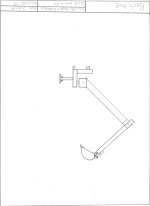I would suggest some dimensions so one has an idea of what the length and size of materials your working with.
I would suggest a hing/pivot, that has two points of support, top and bottom,
If you want 180 degree pivot, one more than likely will not be able to have a solid shaft through the middle unless one uses a chain or some type of movable link or rack and pinon system,
you can get about 140 degree pivot with a solid shaft in the pivot,
my guess is your dipper arm has not enough distance above the pivot point to give enough leverage for your desired wants,
If you are intent on the length of dipper and boom (10 and 8 foot), my guess is you will want cylinders in the 3" to 5" diameter and more than likely you need cylinders in the 30" to 50+" in length to make it work,
before one can work out the lengths and the leverage points one will have to start with some potential cylinders in length and there closed and extended dimensions, other wise about all your doing is making a picture,
as the length of the cylinders will be one of the major design points, and one of the things that will be used to make it work and to design your lengths of leverage and so on.
like I suggested, you may be best to some Internet searches and down load some brochures and pictures of backhoes, and get there specs, and see what there using for cylinders and take there picture and blow it up and start to dimension it and then proportion it to your needs, and adjust the cylinder's to match,
and some of your design of your cylinders is what your power unit has for pressure and gallons a min, of hydraulic capacities,
if it is only a 1000 psi system then your cylinders would need to be nearly 3 times the size IN SQUARE INCHES, (area) than a system that is using 3000 psi,
so jsut because a unit has cylinders, that are 5" in diameter 2.5 x 2.5 x 3.14 = 19.625 square inches, X 1000 psi you will have a push of 19,625 pounds, on the return stroke you need to figure the size of the rod and subtract the rod size.
on a 2000 pound system a 3.5 cylinder will nearly be the same, 1.75 x1.75x3.14 = 9.61625 x 2000= 19,232.5 pounds of push,
so before one can figure out your cylinders you will need to know what your skid loader has for auxiliary hydraulic power. and then start to design from there.

